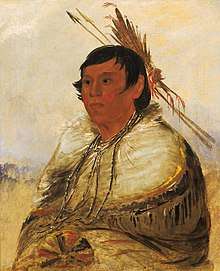Piankeshaw
The Piankeshaw, Piankashaw or Pianguichia Indigenous Peoples are Native Americans and members of the Miami Indians who lived apart from the rest of the Miami nation, therefore they were known as Peeyankihšiaki ("splitting off" from the others, Sing.: Peeyankihšia - "Piankeshaw Person"). They live in an area that now includes western Indiana and Ohio, and are closely allied with the Wea Indians. Piankeshaw villages have been reported along the White River in central Indiana, and along the Vermilion River in Illinois, near Ouiatenon.[1] The Piankashaw were living along the Vermilion river in 1743.[2]
 Portrait of a Piankeshaw by George Catlin. | |
| Total population | |
|---|---|
| extinct as a tribe | |
| Regions with significant populations | |
| United States (Indiana, Ohio, Illinois) | |
| Languages | |
| Miami-Illinois | |
| Religion | |
| Traditional tribal religion | |
| Related ethnic groups | |
| Miami, Wea, Illinois |
History
The first Peeyankihšionki or Piankeshaw Village ("Place of the Piankashaw") was at the confluence of the Peeyankihšiaki Siipiiwi ("River of the Peeyankihšiaki/Piankashaw, i.e. Vermilion River") and the Waapaahšiki Siipiiwi ("white shining", "pure white" or "River over white stones, i.e. Wabash River") northeast of the town of Cayuga, Indiana.
Sometime after the founding of the first Peeyankihšionki, a group split off and moved south following the Waapaahšiki Siipiiwi to just above its confluence with the Embarras River. In that spot they built a village called Aciipihkahkionki / Chippekawkay / Chippecoke ("Place of edible Roots"). This name referred to the abundance of tuberous plants that grew in the area. Today the city of Vincennes, Indiana lies in the vicinity of this historic Peeyankihšia village. Many of the descendants of the Peeyankihšia who built this village and the village to its north are citizens of the Peoria Tribe of Oklahoma. A smaller settlement was located at the confluence of the two main arms of the Vermillion River (near Danville, Illinois).
In the 18th century a third important settlement outside the historic Wabash River Valley was established along the Ahsenisiipi ("Rocky, Stony River; i.e. Great Miami River") and called Pinkwaawilenionki / Pickawillany ("Place of the Ash People") and developed into today's Piqua in western Ohio.
The Piankeshaw are usually regarded as being "friendly" towards European settlers. They intermarried with French traders and were treated as equals by residents of New France in the Illinois Country. A principal Piankeshaw village was established on the Wabash River near what became Vincennes. In fact, some have suggested that the land around the Grand Rapids Hotel that existed in the 1920s was part of a Piankeshaw Summer campground. Like their French neighbors, the Piankeshaw generally sided with the Americans during the American Revolution.
Although part of the Wabash Confederacy, the Piankeshaw nation took no part in the Northwest Indian War that followed the American Revolution. However, Piankeshaw suffered retaliation from U.S. colonizers for attacks made by other native tribes. President George Washington issued a proclamation forbidding harm to the Piankeshaw.[3]
During the late 18th century, the Piankeshaw population began to decline. Many of the Piankeshaw simply left and joined other Miami tribes. After the Americans and French suffered setbacks in the Revolution, notably the disastrous LaBalme expedition, some Piankeshaw joined tribes aligned with the British. At that time, in the West, the British looked as if they would be the victors.[4]
Others left during the economic depression caused by a depreciated United States currency and stagnated fur trade (due to unrest in the Northwest Indian Wars). The Piankeshaw suffered especially when 1781 brought a severe Winter followed by a Summer drought.[5][6]
Despite overall good relations with the new United States, some Piankeshaw resented the new settlers encroaching on their territory. Vincennes residents attacked a nearby village in the 1786 Battle of the Embarras River. An exodus of Piankeshaw left the Vincennes area and moved to Terre Haute, where they joined the Wea, or moved to Kaskaskia, Illinois.[7] They joined with other tribes in attacking American settlers later that year, but aborted the attack after French residents pleaded for peace.[8]
By 1818, the Piankeshaw Chief Chekommia signed a treaty selling rights to much of their land to the United States. There were not enough tribal members (in the eyes of the US government authority) remaining to use it.
Today
The descendants of the Piankeshaw, along with the Kaskaskia and Wea, are enrolled in the Peoria Tribe of Indians of Oklahoma, a federally recognized tribe in Oklahoma.[9]
Notes
- Dorothy Libby, Summary of Piankashaw Locations (1708- ca. 1763) Archived 2008-12-10 at the Wayback Machine pp. 58 - 62
- Anthropological report on the Piankashaw Archived 2009-03-11 at the Wayback Machine
- Beckwith, 112
- Somes, 45
- Somes, 76
- Hoffmeister, Donald F. (2002) [1989]. Mammals of Illinois (1st pbk. ed.). Urbana: University of Illinois Press. pp. 28–29. ISBN 978-0-252-07083-9. OCLC 50649299.
- Libby, pg 140 Archived 2008-03-15 at the Wayback Machine
- Allison, Harold (1986). The Tragic Saga of the Indiana Indians. Paducah: Turner Publishing Company. p. 57. ISBN 0-938021-07-9.
- House, Office of the Law Revision Counsel. United States Code 2006, Volume 15. §1224, page 986
References
- Beckwith, Hiram (1975). Illinois and Indiana Indians. New York: Arno Press.
- Somes, Joseph Henry Vanderburgh (1962). Old Vincennes. New York: Graphic Books.
- Libby, Dr. Dorothy. (1996). "An Anthropological Report on the Piankashaw Indians". Dockett 99 (a part of Consolidated Docket No. 315)]: Glenn Black Laboratory of Archaeology and The Trustees of Indiana University. Archived from the original on 2008-03-15. Cite journal requires
|journal=(help)CS1 maint: location (link)